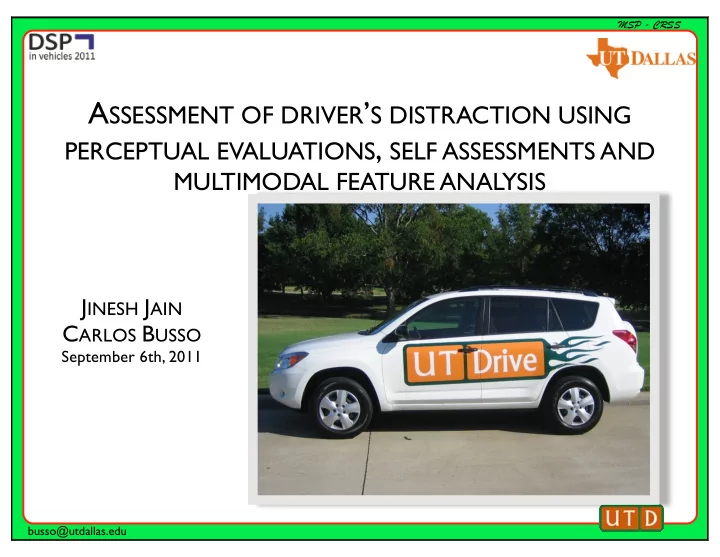

MSP - CRSS A SSESSMENT OF DRIVER ’ S DISTRACTION USING PERCEPTUAL EVALUATIONS , SELF ASSESSMENTS AND MULTIMODAL FEATURE ANALYSIS J INESH J AIN C ARLOS B USSO September 6th, 2011 busso@utdallas.edu
MSP - CRSS Long-Term Goal: Monitoring Driver Behavior /++01.23( !$2&"4-"#+5( !"#$%"&$#'( )&$*+&( ,+-.*$"&( /&"#%.6(7.8+&.( 79:;,<5( =".0(7.8+&.( First step is to define metrics to characterize driver distraction busso@utdallas.edu 2
MSP - CRSS Definitions • Types of Distraction • Visual, cognitive, auditory and physical distractions • Report by Australian Road Safety Board • Voluntary or Involuntary diversion from primary driving task • Not related to impairment due to alcohol, fatigue and drugs • While performing secondary task focusing on a different object, event or person • Reduces situational awareness, decision making abilities busso@utdallas.edu 3
MSP - CRSS Metrics for Distraction • Secondary task performance • Complete artificial detection tasks (e.g., math problem) • Effectiveness (accuracy) and efficiency (required time) • Surrogate schemes • The lane change test (LCT) [Mattes & Hallén, 2008] • Visual occlusion approach [Foley, 2008] • Primary task performance metrics • Lateral control, longitudinal control, brake response busso@utdallas.edu 4
MSP - CRSS Metrics for Distraction • Eye glance behavior • Detailed eye-control metrics (e.g., within-fixation metrics, eye closure pattern, eye-off-the-road duration) • Coarse visual behavior metric (e.g., head movement) • Subjective assessments [Victor, 2008] • Subjective mental workload (NASA-TLX) Not all these metrics can be directly used to define labels to train machine learning busso@utdallas.edu 5
MSP - CRSS Our Goal • To define reference labels for distracted drivers • Facilitate the training of classifiers • Real driving conditions • To explore and compare 3 different approaches: • Self evaluations (post driving questionnaires) • Perceptual evaluations (external raters) • Multimodal feature analysis (deviation from normal behaviors) busso@utdallas.edu 6
MSP - CRSS UTDrive • Front facing camera • PBC-700 • 320 x 240 at 30fps • 4 - channel Microphone array • 25kHz • CAN Bus for Steering wheel, Vehicle speed, Brake, Gas • Road facing camera • 320 x 240 at 15fps busso@utdallas.edu 7
MSP - CRSS Protocol • 2 runs of driving per subject • First run – with 7 tasks • Operating a Radio • Operating Navigation System (GPS) • Operating and following • Cell phone • Operating and talking • Describing Pictures • Conversation with a Passenger 20 drivers • Second run – neutral driving Good Day light, dry weather conditions to reduce environmental factors (without tasks) busso@utdallas.edu 8
MSP - CRSS Self Assessments Secondary tasks • Radio • GPS - Operating • GPS - Following • Phone - Operating • Phone - Talking • Pictures • Assumption: • Conversation • Drivers are aware of the distractions induced by common secondary tasks • Questionnaires completed by drivers after the recording • They rate how distracted they felt while performing tasks • 1 – less distracted, 5 – more distracted busso@utdallas.edu 9
MSP - CRSS Self Assessments • More Distracting • GPS - Operating • Phone - Operating • Less Distracting • GPS - Following • Conversation Visual intensive tasks are perceived more distracting busso@utdallas.edu 10
MSP - CRSS Perceptual Evaluations Secondary tasks • Radio • GPS - Operating • GPS - Following • Procedure: • Phone - Operating • Phone - Talking • Pictures • Videos segmented into 5 sec videos • Conversation • Subset of videos randomly chosen (480 videos) • 3 samples x 8 tasks x 20 drivers = 480 • Twelve evaluators - UTD students ( ρ = 0.63) • Three independent evaluations per video • Advantages • Labels assigned to localized segments • Videos can be assessed by many raters busso@utdallas.edu 11
MSP - CRSS Perceptual Evaluations • More Distracting • Radio • GPS - Operating • Phone - Operating • Pictures • Less Distracting • GPS - Following • Phone - Talking Visual intensive tasks are perceived more distracting • Conversation busso@utdallas.edu 12
MSP - CRSS Secondary tasks Multimodal Feature Analysis • Radio • GPS - Operating • GPS - Following • Phone - Operating • Phone - Talking • Pictures • What features can be used to characterize • Conversation distractions? • Approach: • Contrasting features from task and normal conditions (for each route segment) • Hypothesis testing (matched pairs) busso@utdallas.edu 13
MSP - CRSS Multimodal Feature Analysis • CAN-Bus Information • Steering wheel angle (Jitter), Vehicle Speed, Brake Value, Gas pedal pressures • Frontal Facing video Information: • Head pose (yaw and pitch), eye closure • Extracted with AFECT Courtesy: Machine Perception Laboratory, University of California, San Diego busso@utdallas.edu 14
MSP - CRSS Multimodal Feature Analysis • Matched pairs Hypothesis Testing (p = 0.05) busso@utdallas.edu 15
MSP - CRSS Multimodal Feature Analysis • The mean of head - yaw is an important feature busso@utdallas.edu 16
MSP - CRSS Multimodal Feature Analysis 20 20 Neutral Task 10 10 0 0 − 10 − 10 More distracted − 20 − 20 Neutral Task − 30 − 30 Phone Talking Conversation Radio GPS Operating GPS Following Phone Operating Phone Talking Pictures Radio GPS Operating GPS Following Phone Operating Pictures Conversation • Error plot for the mean of head - yaw busso@utdallas.edu 17
MSP - CRSS Multimodal Feature Analysis • Some tasks produce higher deviation in the features from normal conditions busso@utdallas.edu 18
MSP - CRSS Multimodal Feature Analysis • Other tasks produce small or no deviation in the features from normal conditions busso@utdallas.edu 19
MSP - CRSS Conclusions • Three methodologies to describe drivers’ distraction • Self evaluations • Perceptual evaluations • Multimodal feature analysis • Consistent results are observed across approaches • Visual distractions are better described than cognitive distraction (e.g., Phone - Talking [Strayer et al., 2004] ) • Current work: we are conducting subjective evaluations with mental workload scales busso@utdallas.edu 20
MSP - CRSS Discussion & Questions THANK YOU! busso@utdallas.edu 21
Recommend
More recommend